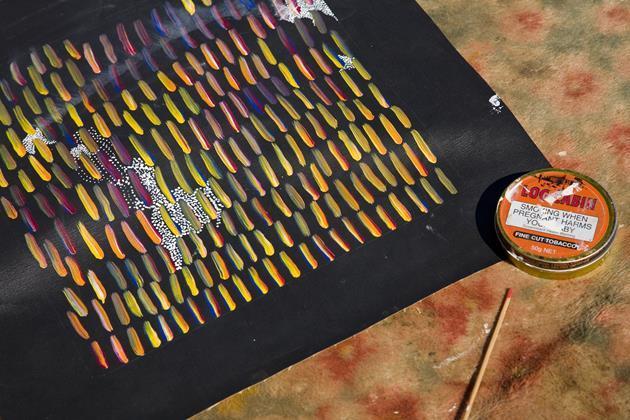Kame, Emily's middle name, means "yam seed." After rains, yam seeds emerge as large edible tubers that can extend for long distances underground. Eventually the yams begin to push up through the dry, hard earth. Evidence of their growth is first seen as elongated cracks hitting the earth's surface. Using wooden digging sticks, women free the yams from the earth. A prized "bush tucker" food, the yams are considered a sweet and juicy delicacy. As a custodian of the yam, Emily conducted singing and dancing ceremonies to help replenish the species.
Photo: Susan Cole
Promised of Margaret Levi and Robert Kaplan in honor of the 75th Anniversary of the Seattle Art Museum. Courtesy Gallerie Australis
Mountain Devil Lizard Dreaming—Winter Storm, 1999, Kathleen Petyarre
Kathleen and Gloria Petyarre are just two of the many artists coming from the Utopia station. Emily Kngwarreye was their aunt, and although a family resemblance is evident in their painting conventions, each has come up with a distinctive style. In addition, each is a custodian of sacred sites and stories that their art is dedicated to.
Kathleen Petyarre creates patiently systematic paintings that trace the journey of a lizard that valiantly contends with sand and hail, heat and dust, and never seems to give up. Here his tendency not to take a direct route is witnessed, as are the conditions he faces in his travels. Swirling dust storms surround the central site that is associated with green pea seeds, the lizard's favorite food.
Promised gift of Margaret Levi and Robert Kaplan in honor of Bagley and Virginia Wright, and in honor of the 75th Anniversary of the Seattle Art Museum. Courtesy Utopia Art Sydney
Leaves, 2002, Gloria Tamerre Petyarre
Enormous canvases filled with flowing patterns, Gloria Petyarre's paintings often call attention to the leaves of a native tree with medicinal properties that grows abundantly in Utopia. Women have sorted through such leaves for countless generations. Ground leaves provide a remedy for coughs, colds and flus. In the form of a paste, the leaves are applied to the skin to cure rashes, boils and scabies.
From Indigenous to International
By visual analysis alone, many recent Australian Aboriginal paintings could be mistaken for late abstract expressionist canvases: intriguing as compositions and making impressive use of gesture. Yet, first impressions can be revised when titles are considered. As with Emily Kngwarreye's dedication to yam dreamings, other titles speak of the journeys of an emu, or a mountain devil lizard or a roaming ancestor. A distant origin is suggested and a worldview in which, as Australian Aboriginal curator, Djon Mundine, has described it, "Every person, place, constellation, wind, cloud, plant, animal, fish, clan, dance and song in between has a value."
For thousands of years, Aboriginal painting appeared primarily on the human body, on the ground, on trees or rock walls or on ceremonial objects. Such art conveyed sacred laws derived from Dreamings, when ancestral beings animated the world. This artistic legacy is the longest continuing artistic tradition on Earth, twice as old as the cave paintings of Lascaux.
In the latest generation, Australian Aboriginal artists have contributed significantly to world art by adapting their knowledge and applying it to painted canvases. These paintings offer a new look at life on the vast stretches of the Australian continent. It also brings viewers closer to a coded system of beliefs, where some of the smallest creatures might have the biggest stories, as seen in paintings by other Utopian artists. This new episode in art history also explores the parameters of abstraction in a way that can be compared to other paintings in SAM's collection.
Utopia Region, Central Australia
Photo: Jake Warga
© Jake Warga, 2006Environmental Abstractions
Autumn Boughs, 1969, Maria Frank Abrams, 70.29
Violet Flapper, 1975, Alden Mason, 75.80
Exuberant Winds, 1976, Kenneth Callahan, 77.14
Antila, 1968, Dan Christensen, 78.25
Night and Day, 1956, Sam Francis, 91.249
Secret Blood, 1987, Ken Kelly, 93.101
Distraction, 1999, Karin Davie, 2002.13
Between Space and Time, 1965, Mark Tobey, 87.23
Photo: Jake Warga
© Jake Warga, 2006
Utopia Region, Central Australia
Photo: Jake Warga
© Jake Warga, 2006
Utopia Region, Central Australia
Photo: Jake Warga
© Jake Warga, 2006
Utopia Region, Central Australia
Photo: Jake Warga
© Jake Warga, 2006
Utopia Region, Central Australia
Photo: Jake Warga
© Jake Warga, 2006
Utopia Region, Central Australia
Photo: Jake Warga
© Jake Warga, 2006
Utopia Region, Central Australia
Photo: Jake Warga
© Jake Warga, 2006
Utopia Region, Central Australia
Photo: Jake Warga
© Jake Warga, 2006
Utopia Region, Central Australia
Photo: Jake Warga
© Jake Warga, 2006
Emily Kame Kngwarreye's tombstone, Utopia Region, Central Australia
Photo: Jake Warga
© Jake Warga, 2006
Utopia Region, Central Australia

















